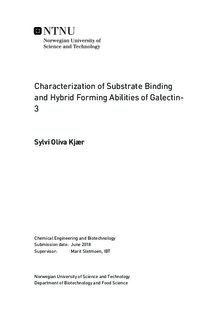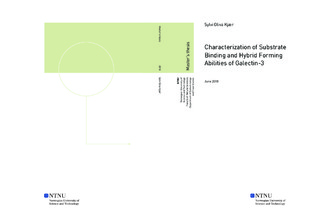| dc.description.abstract | Glycans have over the last decade become a hot topic in biochemistry, cell biology and related research areas. Glycoproteins are today known to have critical roles in the organization and function of eukaryotic cells.
Their incredible ability to store and display complex biological information, explains their crucial roles in a broad spectrum of cellular activities. However, their inherent complexity also raises great challenges in order for researchers to reveal their properties and many questions remain to be answered. Galectins are glycan binding proteins (GBP) that play important roles in interpreting and translating information expressed by glycans into appropriate responses. Understanding GBP - glycan interaction is considered a promising strategy to reveal the mysteries of glycans. In this study, the binding abilities of Galectin-3 in the wild type and the engineered homodimer form was investigated using glycoproteins mucin-1 ST (MUC1(ST)) and asialofetuin (ASF) as ligands. The respective galectins and glycoproteins were immobilized on polystyrene beads and the inter-molecular binding force was quantified using optical tweezers. The results obtained in this study showed that interactions between Gal-3 WT and ASF, Gal-3 homodimer and ASF, Gal-3 WT and MUC1(ST) and Gal-3 homodimer - MUC1(ST) do form. Rupture forces were found to increase between 6.2 - 13.6 pN for loading rates between 45 - 158 pN/s for the Gal-3 WT ASF system, between 10.1 - 28.1 pN for loading rates between 108 - 316 pN/s for Gal-3 homodimer ASF, between 13.8 - 23.3 pN for loading rates between 63 - 213 pN/s for Gal-3 WT MUC1(ST), and finally, between 8.8 - 28.6 pN for loading rates between 44 - 233 pN/s for Gal-3 homodimer - MUC1(ST). A slight difference in rupture force was observed between the two glycosylated proteins ASF and MUC1(ST). This difference might be explained by the different sugar moieties on the epitopes: LacNAc on ASF and Neu5Ac on MUC1(ST) or multiplicity due to the structural properties of the glycoproteins. In addition, the heterodimeric hybrid forming abilities of Gal-3 WT were investigated with the same approach, using Gal-1 WT and Gal-7 WT as ligands. It was found that Gal-3 WT seems to exhibit a certain inherent specificity to both galectins. Still, a lot is yet to be revealed related to in vivo behaviour of Gal-3, where research suggests multivalency to be a key feature. Furthermore, the hybrid forming abilities of galectins may potentially influence our future interpretation of galectin behaviour. | |

